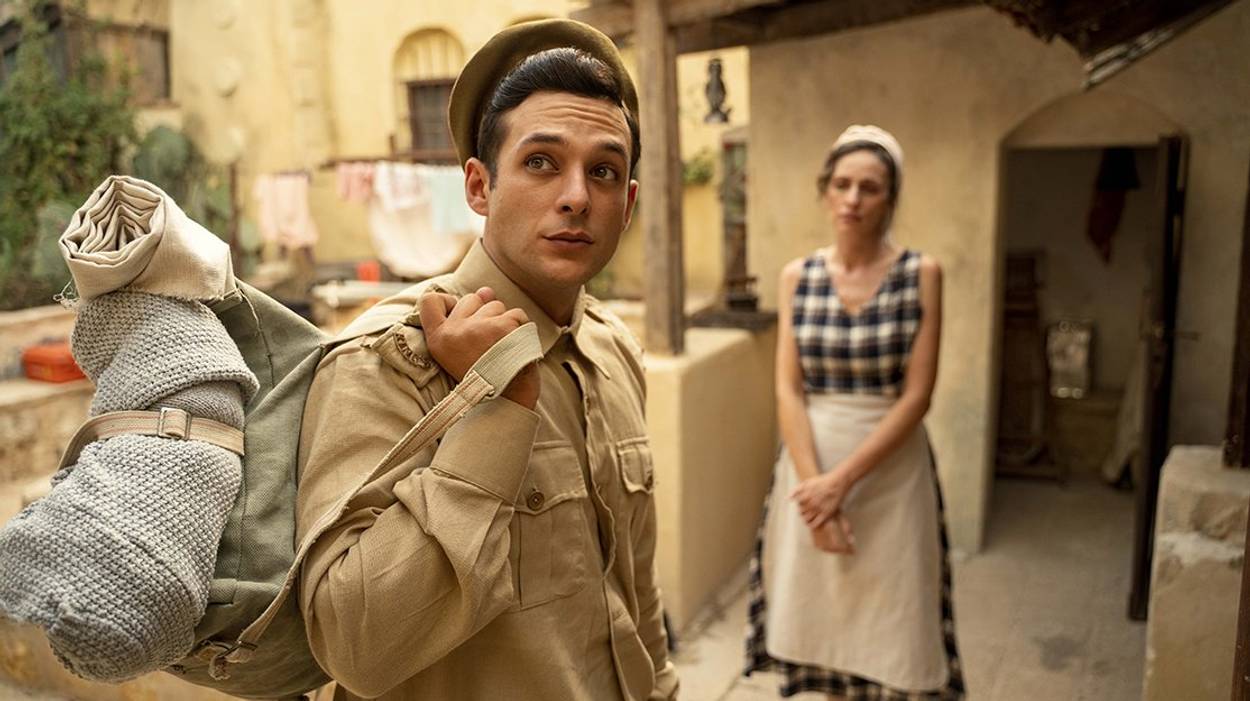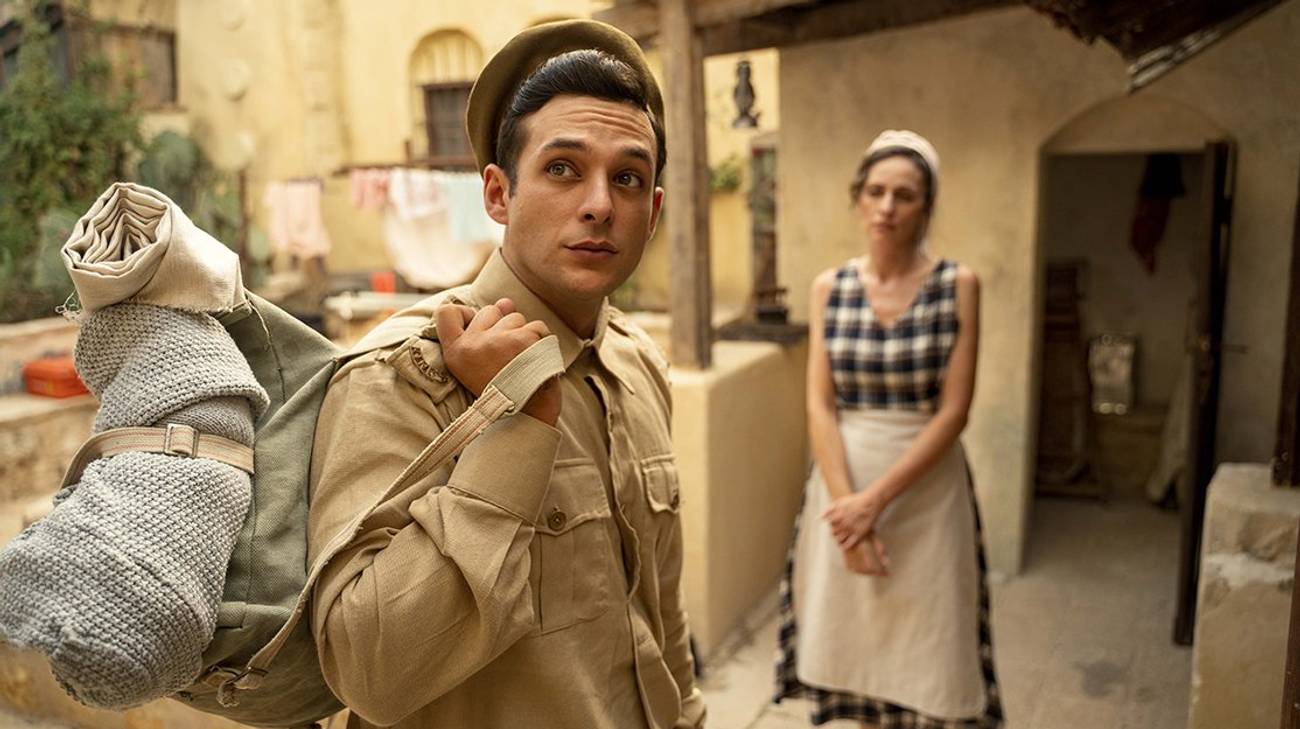The Beauty Queen of Jerusalem
At best, Israel’s latest hit television show is plodding and predictable. At worst, it is willfully and dangerously ahistorical.




Israeli television’s latest hit, The Beauty Queen of Jerusalem, is melodramatic, plodding, predictable, and, by American standards at least, culturally inappropriate. It is also ahistorical and politically biased. Most disconcertingly, though, at a time when Israel is increasingly believed to have been born of militarism, racism, and colonialism, The Beauty Queen of Jerusalem is silent about these charges. At its worst, it corroborates them.
Based on a bestselling novel by Sharit Yishai-Levi, the series follows the vicissitudes of the Ermozas, an upscale Sephardi family in pre-state Jerusalem. Clumsily toggling between the early 1920s and late ’30s, the drama focuses on the materfamilias, Merkada, and her sybaritic son, Gabriel. The owner of a store that appears to sell only halvah, Gabriel falls in love with a working-class Ashkenazi woman but is forced by Merkada to marry an even lower-class Sephardi woman, their illiterate housekeeper, Rosa. Played by the alpaca-eyed Hila Saada, Rosa inundates the show with a stream of tears that stretches across all 16 of its first-season episodes. And there are the Ermoza daughters—Rachelika and Luna, with the latter growing up to become the eponymous beauty queen. Their loves and disasters, longings and disappointments take place against the backdrop of Palestine from the end of the Ottoman Empire and throughout the British Mandate.
It was a period of relentless instability, punctuated by outbursts of internecine violence. It began in Jerusalem in April 1920, when thousands of Arabs, led by the fiercely antisemitic Hajj Amin al-Husayni and chanting “Palestine is our land, the Jews are our dogs,” ravaged the Old City’s Jewish Quarter. Hours of looting, raping, and murder left five Jews dead and 216 injured. Some 300 Jews had to be evacuated. The following April saw another spate of pogroms, this time directed at the Jews of Jaffa and Petah Tikvah. Eight years later, the same al-Husayni—since dubbed Grand Mufti by the British—claimed that the Jews were plotting to take over the al-Aqsa mosque. The libel incited Arab mobs to massacre the Jewish communities of Sefad and Hebron and overrun Kibbutz Mishmar Haemek. In Jerusalem, dozens of Jews were killed and wounded both within and outside the Old City walls.
This Arab-Jewish friction came to a head in the Arab Revolt, lasting from 1936 to 1939, when Palestinian irregulars attacked both Jewish and British targets. The result was a disaster from which the Palestinian nationalist movement never recovered. While 90 Jews were murdered and many more wounded, an estimated 10% of all adult Palestinian males were either killed, wounded, or jailed. Haj Amin al-Husseini took his Grand Mufti title with him to exile in Beirut, and from there to Berlin where he became an honored guest of Adolf Hitler and supporter of the Final Solution.
The Arab revolts of the 1920s and ’30s demonstrated that Arab opposition to the Jewish presence in Palestine began well before the founding of Israel and was directed at all Jews, even the non-Zionist ultra-Orthodox. The rebellions established a precedent—later replicated during the Second Intifada of 2000-2005—in which radical Palestinian leaders cited imaginary threats to the Islamic holy places and fomented unrest that claimed many Jewish lives but mostly proved disastrous for the Palestinians. Finally, pre-state Palestinian attacks against the Jews bore an antisemitic stamp that became more pronounced with the rise of Nazism.
Jew hatred was not only metastasizing in Germany during this time, but throughout Europe, convincing many Jews to emigrate. Palestine’s Jewish population swelled sixfold, from a mere 84,000 to a half a million. The expansion stoked Arab fears of Jewish dominance and helped trigger the revolts which, in turn, drove the British to retreat from the Mandate’s promises.
These promises, as approved by the League of Nations in 1922, were to recognize “the historical connection of the Jewish people with Palestine,” and assist them in “reconstituting their national home in that country.” To this end, the British were to promote the establishment of Jewish self-government in the country and facilitate Jewish immigration. But such aspirations fell victim to a pattern in which waves of Jewish refugees were met by Arab rebellions that threatened Britain’s Middle East empire at a time of mounting international tensions. And each uprising was followed by an investigative commission and a white paper recommending cutbacks in Jewish immigration and land purchases. Mandatory officials grew vocal in their opposition to Zionism, with some of them becoming openly antisemitic. Finally, in 1939, Britain issued a white paper that essentially closed Palestine’s doors to European Jews, dooming them to the death camps.
No wonder Labor Zionist leader David Ben-Gurion vowed “to fight the White Paper as if there were no war and to fight the war as if there were no White Paper.” Both the mainstream Haganah (Defense) and the Revisionist Irgun (the National Military Organization) volunteered to serve in the British Army. Only one faction—Lehi (Fighters for the Freedom of the Land of Israel)—broke away from the Irgun in 1940 and focused on fighting the British. By 1945, after the war’s end, all three Zionist militias joined in an effort to drive the British from Palestine. It was one of the first successful postwar struggles against colonialism, inspiring similar insurrections in Africa, India, and the Far East.
What drama! Surely any historical series would incorporate these hugely consequential events, weaving them into the storyline, showing how they impacted the protagonists’ lives. But remarkably, appallingly, The Beauty Queen of Jerusalem, makes no reference to them whatsoever—not to the Arab revolts, not to rising antisemitism, not to Nazism. It has more to say about halvah than the impending Holocaust. And while British officials abound throughout the series, they are overwhelmingly positive figures, free of any prejudice toward either Zionism or Jews.
Some of this might be attributed to the nostalgia harbored by some Israeli leftists for the years of British rule and what they believe was its secular and fair-minded officials. “The British had found an underdeveloped country when they arrived and they left behind much progress,” wrote radical leftist historian Tom Segev, “especially among the Jews.” Similar impulses may have led the scriptwriter to underplay the widespread Arab belligerence at the time, even toward the non-Zionist communities of Hebron and Safed. Such attacks belie the left-wing claim that the Israeli-Palestinian conflict originated in the sins of Israel’s expulsion of the Palestinians in the 1948 War of Independence and its capture of Palestinian land in the Six-Day War of 1967.
Accordingly, and unsurprisingly, the only villains in The Beauty Queen of Jerusalem are Jews. And not just any Jews, but the right-wing Revisionists of the Irgun and the Lehi. A ruthless bunch, including Rosa’s brother, Ephraim, they blow up a British officers club in 1937, killing soldiers and civilians alike, and assassinate innocent Arabs. “First we get rid of the English,” the ringleader declares. “Then we get rid of the Arabs, and then we get rid of the Mapainikim.” That third target—a reference to members of Ben-Gurion’s Mapai (the Land of Israel Workers Party)—is the most abhorred by the terrorists. For that is how they are portrayed, as bloodthirsty and treasonous.
These villains are also decontextualized. Like the Haganah, the Irgun was founded in reaction to the Arab revolts, as a means of protecting Jewish settlements and neighborhoods from terrorism. Attacks on the British began only in 1939, after the issuance of the white paper. But since none of this background is supplied or even alluded to in the show, the Revisionists appear motivated by bloodlust alone. “When did it happen to us?” a despondent Gabriel Ermoza asks. “When did it happen that we kill a man just because he’s an Arab?” Ultimately, in fact, Jews did kill Jews, in June 1948, when Israeli forces led by Ben-Gurion opened fire on the Revisionist arms ship, Altalena.
Ahistoricism and heavy-handed politicization are not, unfortunately, the program’s only flaws. Produced by the makers of Fauda, Shtisel, and Tehran, The Beauty Queen of Jerusalem is certainly destined for the American market. And yet by casting Ashkenazi actors—Michael Aloni as Gabriel, and Irit Kaplan as his mother—in its lead Sephardic roles, the series is liable to receive allegations of cultural appropriation. It might lend credence to the widespread American view of Israel as a majority-white country. American viewers are also likely to take umbrage at the series’ depiction of Arabs, all of whom are docile or decadent stereotypes.
But Americans, especially those unfamiliar with the seminal events in Israel’s history, will probably not resent—or even notice—the absence of any mention of the Mufti, the Arab Revolts, or Nazism. This is the series’ tragedy. Rather than reminding American audiences that the conflict did not begin in 1967 or even in 1948, but in the 1920s and ’30s when the Arabs attacked all Jews, Zionist and non-Zionist alike, the series lets the distortion stand. Instead of showing how the Arab resistance movement was riddled with religious fanaticism and hatred, the program ascribes precisely those attributes to Jews. And though Zionists spearheaded one of the earliest and most successful campaigns against colonialism, The Beauty Queen of Jerusalem, transforms freedom fighters into psychopaths and the imperialists into victims. Hundreds of thousands of Jewish refugees flooded Palestine during this period and showing them, or even alluding to their presence, would have recalled the need for a secure Jewish state, but The Beauty Queen of Jerusalem fails to present the most basic context to the story it purports to tell.
These and other missed opportunities mar the series far more than its soap opera-ish characters and lugubrious pacing. Most distressing, though. is the producers’ assumption that Israelis would watch the show and not find anything amiss. Forgetfulness might be unfortunate for Americans, but for Israelis it is dangerous. After all, why defend a country whose founders fought against a perfectly peaceful mandate and willfully killed Arabs? Why remain in a state whose very foundations are steeped in ethnic and religious strife? And how beautiful can any queen really be if her realm is built on myths?
Michael Oren, formerly Israel’s Ambassador to the United States, a Member of the Knesset, and Deputy Minister in the Prime Minister’s Office, is the author of To All Who Call in Truth (Wicked Son, 2021).